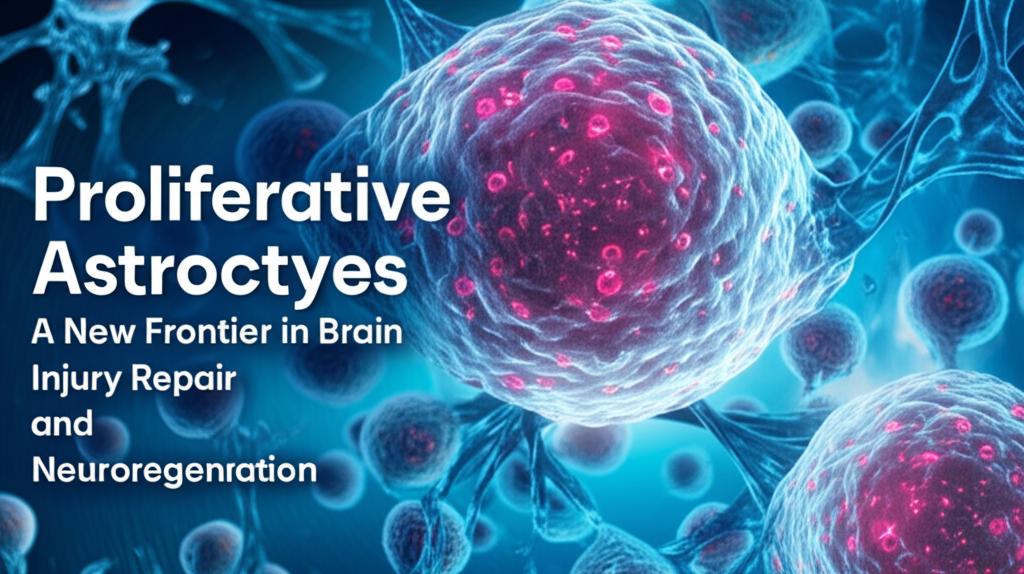Astrocytes, the star-shaped glial cells once considered mere support cells in the central nervous system (CNS), are now recognized as dynamic players in brain injury and repair. Their ability to proliferate, a process known as reactive astrogliosis, is increasingly understood as a complex and multifaceted response with significant implications for neuroregeneration. While historically viewed as a barrier to recovery, recent research highlights the neuroprotective and regenerative potential of these proliferating cells.
Following an injury to the brain, such as a traumatic brain injury (TBI) or stroke, astrocytes undergo a series of molecular, morphological, and functional changes. A key aspect of this response is their proliferation, which contributes to the formation of a glial scar. This scar was traditionally seen as detrimental, physically and chemically hindering axonal regrowth. However, newer evidence reveals that this astrocyte border is crucial for containing the injury, limiting the spread of inflammation and protecting viable neural tissue. Studies have shown that ablating these newly proliferated, border-forming astrocytes can worsen inflammation, increase lesion size, and impair neurological recovery.
The roles of proliferative astrocytes are diverse and context-dependent. They are not a uniform population; instead, they exhibit heterogeneity in gene expression, morphology, and function depending on the nature and severity of the injury. Some reactive astrocytes, often referred to as A2-like or neuroprotective, actively contribute to tissue repair and regeneration. They release a variety of beneficial molecules, including neurotrophic factors that support neuronal survival and growth, and anti-inflammatory cytokines that help to resolve inflammation. Furthermore, astrocytes play a vital role in angiogenesis (the formation of new blood vessels), which is essential for restoring blood flow and providing nutrients to the damaged area. They also contribute to synaptogenesis, the formation of new synapses, which is critical for restoring neural circuits and function.
An exciting area of research is the potential of reactive astrocytes to directly contribute to neurogenesis. Some studies have demonstrated that, under certain conditions, reactive astrocytes in animal models can be reprogrammed or can transdifferentiate into neuroblasts, which can then develop into mature neurons. This regenerative capacity opens up new avenues for therapeutic interventions aimed at replacing lost neurons after brain injury. Gene therapy approaches are being explored to directly convert reactive astrocytes into functional neurons within the injured brain, which has shown promise in reducing neuroinflammation and restoring blood vessels.
Moreover, proliferative astrocytes are involved in maintaining the integrity of the blood-brain barrier (BBB). Following injury, the BBB is often compromised, leading to further damage. Reactive astrocytes contribute to BBB repair by releasing extracellular matrix components and other factors. They also play a role in clearing cellular debris and managing the inflammatory response through phagocytic activity and by regulating immune cell activity.
However, the response of proliferative astrocytes is not always beneficial. In some contexts, particularly in chronic phases or severe injuries, a subset of reactive astrocytes (sometimes termed A1-like or neurotoxic) can release pro-inflammatory factors and cytotoxic molecules that exacerbate neuronal damage and inhibit recovery. Understanding the signaling pathways that determine the phenotype of reactive astrocytes – whether they adopt a neuroprotective or neurotoxic profile – is a key area of ongoing research. Factors released from microglia and other immune cells, as well as signals from the injury microenvironment itself, appear to play crucial roles in modulating astrocyte behavior.
The intricate signaling pathways that govern astrocyte proliferation and function are complex and involve numerous molecules and receptors. For example, signaling through pathways like STAT3, Shh, and various growth factor receptors has been implicated in regulating astrocyte proliferation and scar formation. The endothelin B receptor (ETBR) expressed on astrocytes is another target that influences astrocyte hypertrophy and proliferation.
The dynamic nature of proliferative astrocytes presents both challenges and opportunities for therapeutic intervention. Strategies are being developed to modulate astrocyte activity to enhance their beneficial effects while mitigating their detrimental ones. This could involve promoting the A2-like neuroprotective phenotype, stimulating their neurogenic potential, or carefully managing scar formation to be protective without being overly inhibitory to regeneration. Targeting specific molecular pathways in astrocytes could offer novel approaches to treat a range of CNS disorders, including TBI, stroke, and neurodegenerative diseases.
In conclusion, proliferative astrocytes represent a new frontier in the quest for effective treatments for brain injury and neurodegenerative conditions. Moving beyond the traditional view of the glial scar as solely an impediment, researchers are now uncovering the remarkable plasticity and regenerative potential of these cells. By deciphering the complex signals that control their proliferation and function, and by developing strategies to harness their beneficial properties, we may unlock new therapeutic avenues to promote brain repair and restore neurological function.

